Complete Solutions to physics of chapter WAVES of Class 12 book with complete answers and questions
| Class 12 | PHYSICS |
| Chapter | WAVES |
| DISHA | physics |
| Number Of Questions | 59 |
| Academic Year | 2023-24 |
A police car moving at 22 m/s, chases a motorcylist. The police man sounds his horn at 176 Hz, while both of them move towards a stationary siren of frequency 165 Hz. Calculate the speed of the motorcycle, if it is given that he does not observes any beats
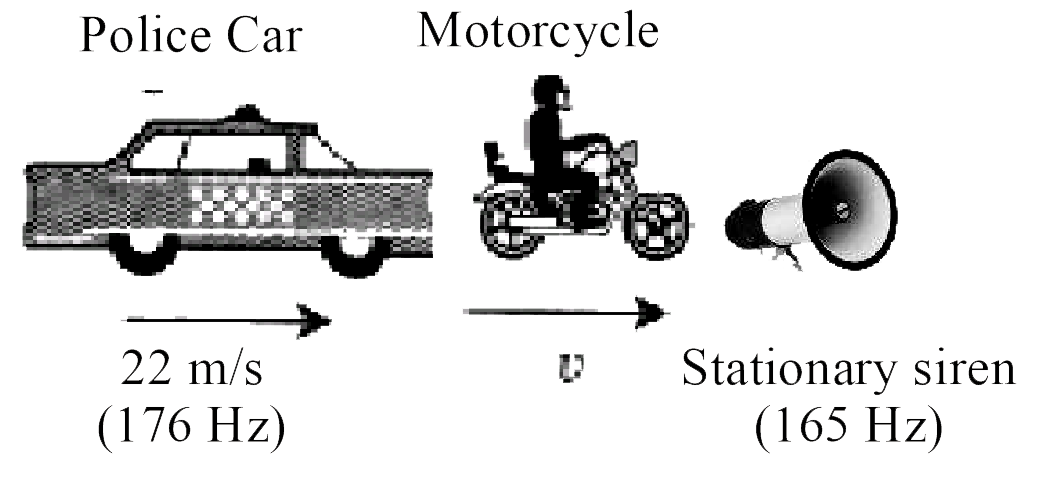
View SolutionA closed organ pipe of length `L` and an open organ pipe contain gass of densities `rho_(1)` and `rho_(2)`, respectively. The compressibility of gass are equal in both the pipes. Both the pipes are vibrating in their first overtone with same frequency . The length of the open orange pipe is
(a) `(L)/(3)`
`(4l) / (3)`
(c ) `(4l)/(3)sqrt((rho_(1))/(rho_(2)))`
(d) `(4l)/(3)sqrt((rho_(2))/(rho_(1)))`
View SolutionTwo whistles Aand B produces notes of frequencies 660 Hz and 596 Hz respectively. There is a listener at the mid- point of the line joining them. Now the whistle B and the listener start moving with speed 30 m/s away from the whistle A. If speed of sound be 330 m/s, how many beats will be heard by the listener
View SolutionAn open pipe is in resonance in `2nd` harmonic with frequency `f_(1)`. Now one end of the tube is closed and frequency is increased to `f_(2)` such that the resonance again ocuurs in `nth` harmonic. Choose the correct option
View SolutionThe source producing sound and an observer both are moving along the direction of propagation of sound waves. If the respective velocities of sound, source and an observer are `v, v_(s)` and `v_(0)`, then the apparent frequency heard by the observer will be (n = frequency of sound)
View SolutionA whistle sends out 256 waves in a second. If the whistle approaches the observer with velocity 1/3 of the velocity of sound in air, the number of waves per second the observer will receive
View SolutionA source of sound emitting a note of frequency 200 Hz moves towards an observer with a velocity v equal to the velocity of sound. If the observer also moves away from the source with the same velocity v, the apparent frequency heard by the observer is
View SolutionThe speed of sound in air at a given temperature is 350 m/ s. An engine blows whistle at a frequency of 1200 cps. It is approaching the observer with velocity 50 m/s. The apparent frequency in cps heard by the observer will be
View SolutionA source of sound of frequency `n` is moving towards a stationary observer with a speed S. If the speed of sound in air is V and the frequency heard by the observer is `n_(1)` ,the value of `n_(1)//n` is
View SolutionAn observer is moving away from source of sound of frequency 100 Hz. His speed is 33 m/s. If speed of sound is 330 m/s, then the observed frequency is
View SolutionA whistle giving out `450 H_(Z)` approaches a stationary observer at a speed of `33 m//s`. The frequency heard the observer (in `H_(Z)`) is (speed of sound `= 330 m//s`)
View SolutionTwo sirens situated one kilometer apart are producing sound of frequency 330 Hz. An observer starts moving from one siren to the other with a speed of `2m//s`. If the speed of sound be `330 m//s`, what will be the beat frequency heard by the observer?
View Solution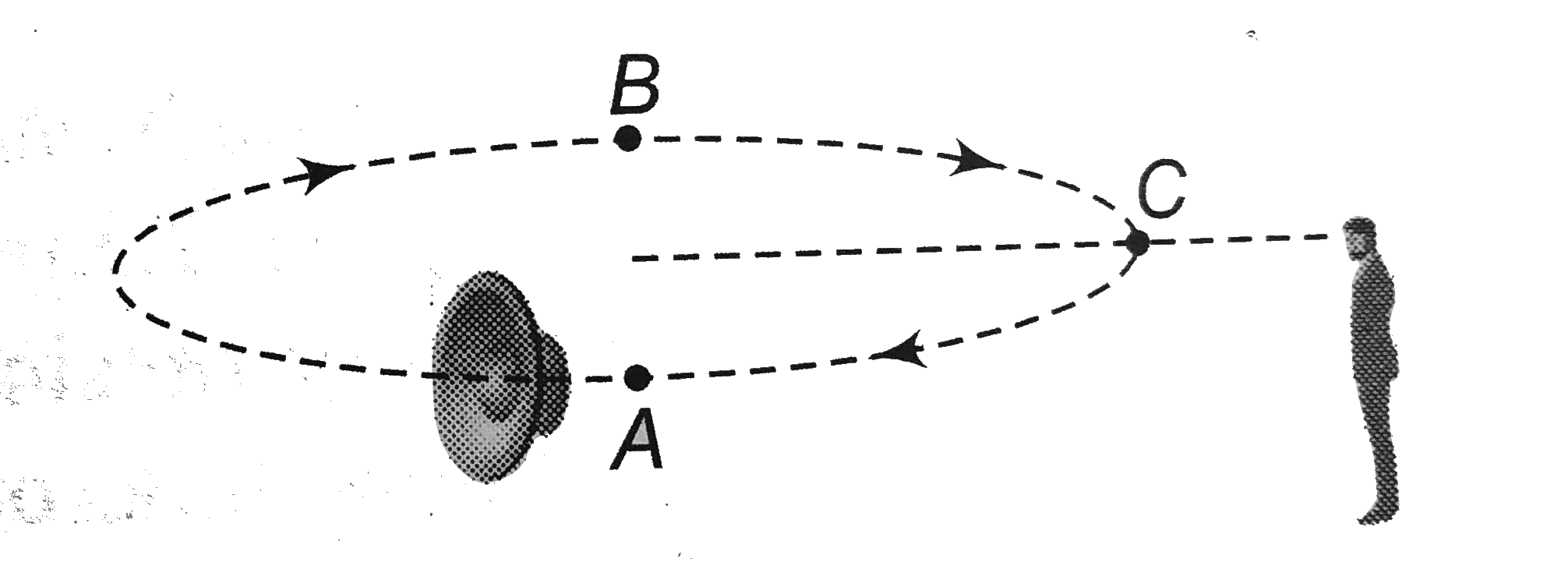
A small source of sound moves on a circle as shown in the figure and an observer is standing on O. Let `n_1`,`n_2` and `n_3` be the frequencies heard when the source is at A, B and C respectively. Then
View SolutionA person carrying a whistle emitting continuously a note of `272 Hz` is runnig towards a reflecting surface with a speed of `18km//h`. The speed of sound in air is `345ms^(-1)` The number of beats heard by him is
View SolutionA source of sound of frequency 256 Hz is moving towards a wall with a velocity of 5 m/s. How many beats per second will be heard by an observer O standing in such a positoin that the source S is between O and wall? `(c=330(m)/(s)`)
View SolutionThe harmonics which are present in a pipe open at one end are
View SolutionA source of sound placed at the open end of a resonance column sends an acoustic wave of pressure amplitude `P_(0)` inside the tube. If the atmospheric pressure is `P_(A)`, then the ratio of maximum and minimum pressure at the closed end of the tube will be
View SolutionThe frequency of fundamental tone in an open organ pipe of length 0.48 m is 320 Hz. Speed of sound is 320 m/sec. Frequency of fundamental tone in closed organ pipe will be
View SolutionA standing wave having 3 nodes and 2 antinodes is formed between two atoms having a distance 1.21Å between them. The wavelength of the standing wave is
View SolutionA string on a musical instrument is 50 cm long and its fundamental frequency is 270 Hz. If the desired frequency of 1000 Hz, is to be produced, the required length of the string is
View SolutionThe loudness and the pitch of a sound depends on
View SolutionIf in an experiment for determination of velocity of sound by resonance tube method using a tuning fork of `512 Hz`, first resonance was observed at` 30.7 cm` and second was obtained at `63.2 cm`, then maximum possible error in velocity of sound is (consider actual speed of sound in air is `332m//s
View SolutionYou are given four tuning forks, the lowest frequency of the fork is 300Hz. By striking two tuning forks at a time any of 1, 2, 3, 5, 7 & 8 Hz beat frequencies are heard. The possible frequencies of the other three forks –
(1) 301, 302 & 307
(2) 301, 303 & 308
(3) 300, 304 & 307
(4) 305, 307 & 308
View SolutionDoppler shift in frequency depends upon
(1) the frequency of the wave produced
(2) the velocity of the source
(3) the velocity of the observer
(4) distance from the source to the listener
View SolutionThe `(x, y)` co-ordinates of the corners of a square plate are `(0, 0)`, `(L, L)` and `(0, L)`. The edges of the plate are clamped and transverse standing waves are set up in it. If `u(x, y)` denotes the displacement of the plate at the point `(x, y)` at some instant of time, the possible expression `(s)` for `u` is (are) `(a = positive constant)`
View SolutionA plate was cut from a quartz crystal and is used to control the frequency of an oscillating electrical circuit. Longitudinal standing waves are set up in the plate with displacement antinodes at opposite faces. The fundamental frequency of vibration is given by the equation `f_(0) = (2.87 xx 10^(4))/(s)` .Here s is thickness of the plate and density of quartz is `2658.76 kg//m^(3)`
Young’s modulus of elasticity for quartz is –
View SolutionA plate was cut from a quartz crystal and is used to control the frequency of an oscillating electrical circuit. Longitudinal standing waves are set up in the plate with displacement antinodes at opposite faces. The fundamental frequency of vibration is given by the equation `f_(0) = (2.87 xx 10^(4))/(s)` .Here s is thickness of the plate and density of quartz is `2658.76 kg//m^(3)`
If the quartz plate is vibrating in 3rd harmonic while measuring the frequency of `1.2 xx 10^(6)` Hz, then the thickness of the plateis
View SolutionStatement-1 : Beats cannot be produced by light sources. Statement-2: Light sources have constant phase difference
View SolutionAssertion : In the case of a stationary wave, a person hear a loud sound at the nodes as compared to the particles of the medium vibrate in phases. Reason: in a stationary wave all particles of the medium vibrate in a phase
View SolutionAssertion : Velocity of particles, while crossing mean position (in stationary waves) varies from maximum at antinodes to zero at nodes.Reason:Amplitude of vibration is maximum at antinodes and at nodes amplitude is zero and all the particles between two successive nodes across the mean position together.
View SolutionA tuning fork makes `256` vibrations per second in air. When the speed of sound is `330 m//s`, the wavelength of the note emitted is :
View SolutionIn a sinusoidal wave the time required for a particular point to move from equilibrium position to maximum displacement is `0.17s`, then the frequency of wave is:
View SolutionA man is standing between two parallel cliffs and fires a gun. If he hears first and second echoes after 1.5 s and 3.5s respectively, the distance between the cliffs is (Velocity of sound in air `= 340 ms^(–1)` )

View SolutionThe velocities of sound at same temperature in two monoatomic gases densities `rho_(1)` and `rho_(2)` are `v_(1)` and `v_(2)` repectively , if `(rho_(1))/(rho_(2)) = 4 `, then the value of `(v_(1))/(v_(2))` will be
View SolutionA wave of frequency 500 Hz has velocity 360 m/sec. The distance between two nearest points `60^(@)` out of phase, is
View SolutionTwo waves are given by`y_(1) = a sin (omega t - kx)` and `y_(2) = a cos (omega t - kx)`. The phase difference between the two waves is
View SolutionThe relation between time and displacement for two particles is given by
`y = 0.06 sin 2 pi (0.04 t + phi_(1)),y_(2) = 0.03 sin 2 pi (1.04 t + phi_(2))`
The ratio of the intensities of the waves produced by the vibrations of the two particles will be
View SolutionA travelling wave is described by the equation `y = y_(0) sin ((ft - (x)/lambda))`. The maximum particle velocity is equal to four times the wave velocity if
View SolutionWhich one of the following does not represent a travelling wave?
View SolutionThe path difference between the two waves
`y_(1)=a_(1) sin(omega t-(2pi x)/(lambda)) and y(2)=a_(2) cos(omega t-(2pi x)/(lambda)+phi)` is
View SolutionA transverse wave is represented by the equation
`y=y_0sin.(2pi)/(lamda)(vt-x)`
For what value of `lamda`, the maximum particle velocity equal to two times the wave velocity?
View SolutionThe equation of a plane progressive wave is given by`y = 0.025 sin (100 t + 0.25 x)`.The frequency of this wave would be
View SolutionA wave travelling in positive X-direction with `A=0.2m` has a velocity of `360 m//sec` if `lamda=60m`, then correct exression for the wave is
View SolutionThe equation of a wave is given as`y = 0.07 sin (12 pi x - 3000 pi t)`. . where xis in metre and t in sec, then the correct statement is
View SolutionThe equation of a progressive wave is given by `y = 0.5 sin (20 x - 400 t)` where xand y are in metre and tis in second. The velocity of the wave is
View SolutionThere is a destructive interference between the two waves of wavelength `lambda` coming from two different paths at a point. To get maximum sound or constructive interference at that point, the path of one wave is to be increased by
View SolutionIf two waves of same frequency and same amplitude superimpose and produce third wave of same amplitude, then waves differ in phase by –
View SolutionEquation of motion in the same direction is given by `y_1=Asin(omegat-kx)`,`y_2=Asin(omegat-kx-theta)`. The amplitude of the medium particle will be
View SolutionThe amplitude of a wave represented by displacement equation `y=(1)/(sqrta)sinomega+-(1)/(sqrtb)cosomegat` will be
View SolutionThe displacement of a wave disturbance propagating in the positive x-direction is given by
`y =(1)/(1 + x^(2))`at `t = 0` and `y =(1)/(1 +(x - 1)^(2))` at `t =2s`
where, `x` and `y` are in meter. The shape of the wave disturbance does not change during the propagation. what is the velocity of the wave?
View SolutionP, Q and R are three particles of a medium which lie on the x-axis. A sine wave of wavelength `lambda` is travelling through the medium in the x-direction. P and Q always have the same speed, while P and R always have the same velocity.
The minimum distance between –
(1) P and Q is `lambda`
(2) P and Q is `lambda//2`
(3) P and R is `lambda//2`
(4) P and R is `lambda`
View SolutionA wave represented by the given equation`Y = A sin (10 pi x + 15 pi t + (pi)/(3))` , where x is in meter and t is in second. The expression represents
(1) A wave travelling in the negative X direction with a velocity of 1.5 m/sec
(2) A wave travelling in the negative X direction with a wavelength of 0.2 m
(3) A wave travelling in the positive X direction with a velocity of 1.5 m/sec.
(4) A wave travelling in the positive X direction with a wavelength of 0.2 m
View SolutionIt is usually more convenient to describe a sound wave in terms of pressure wave as compared to displacement wave because –
(1) Two waves of same intensity but different frequencies have different displacement amplitude but same pressure amplitude
(2) The human ear responds to the change in pressure and not to the displacement wave.
(3) The electronic detector (microphone) does respond to the change in pressure but not to the displacement.
(4) None of the above
View SolutionSound from a point isotropic source spreads equally in all directions in homogeneous medium. Therefore its intensity decreases with square of distance from the source. When distance between observer and the source changes, apart from changes in intensity, the observer listens sound of pitch higher or lower than actual pitch depending upon the fact that the distance between the observer and source is decreasing or increasing respectively. An observer O is at a distance 2R from centre of a circle of radius R. A point isotropic sound source S moves on the circle with uniform angular velocity`omega = pi//3 " rad"//s`. Initially observer, source and centre of the circle are in same line.
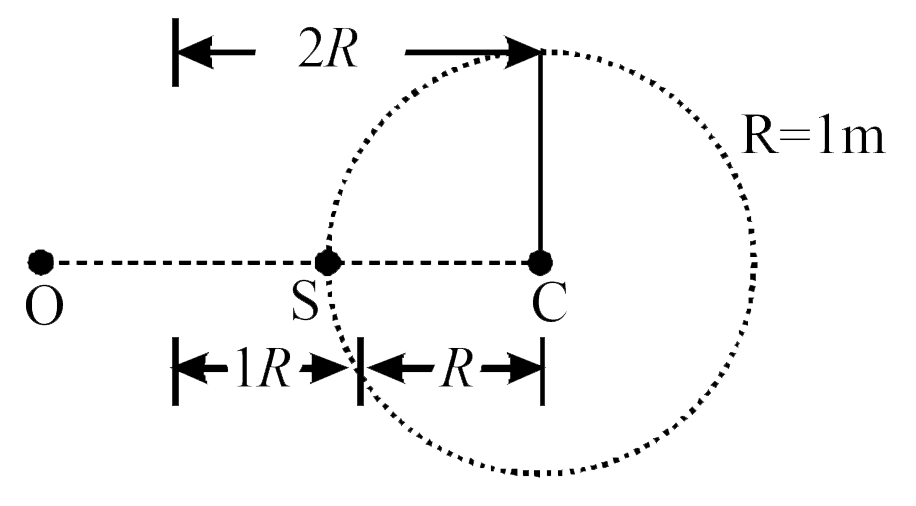
Starting from initial moment, the source moves through an angular displacement `180^(@)`. Intensity of the sound as observed by the observer decreases by a factor of –
View SolutionSound from a point isotropic source spreads equally in all directions in homogeneous medium. Therefore its intensity decreases with square of distance from the source. When distance between observer and the source changes, apart from changes in intensity, the observer listens sound of pitch higher or lower than actual pitch depending upon the fact that the distance between the observer and source is decreasing or increasing respectively. An observer O is at a distance 2R from centre of a circle of radius R. A point isotropic sound source S moves on the circle with uniform angular velocity`omega = pi//3 " rad"//s`. Initially observer, source and centre of the circle are in same line.
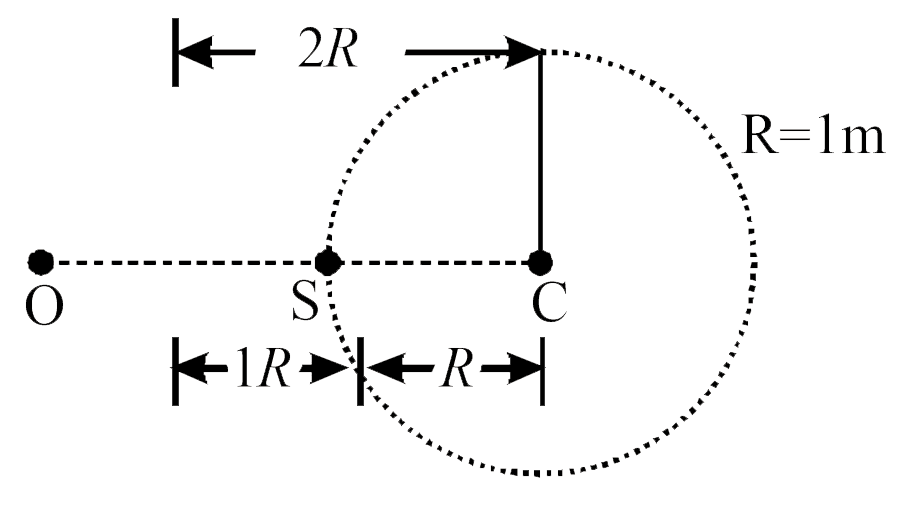
During a complete round trip of star on the circle, the observer listens a sound, whose –
View SolutionSound from a point isotropic source spreads equally in all directions in homogeneous medium. Therefore its intensity decreases with square of distance from the source. When distance between observer and the source changes, apart from changes in intensity, the observer listens sound of pitch higher or lower than actual pitch depending upon the fact that the distance between the observer and source is decreasing or increasing respectively. An observer O is at a distance 2R from centre of a circle of radius R. A point isotropic sound source S moves on the circle with uniform angular velocity`omega = pi//3 " rad"//s`. Initially observer, source and centre of the circle are in same line.
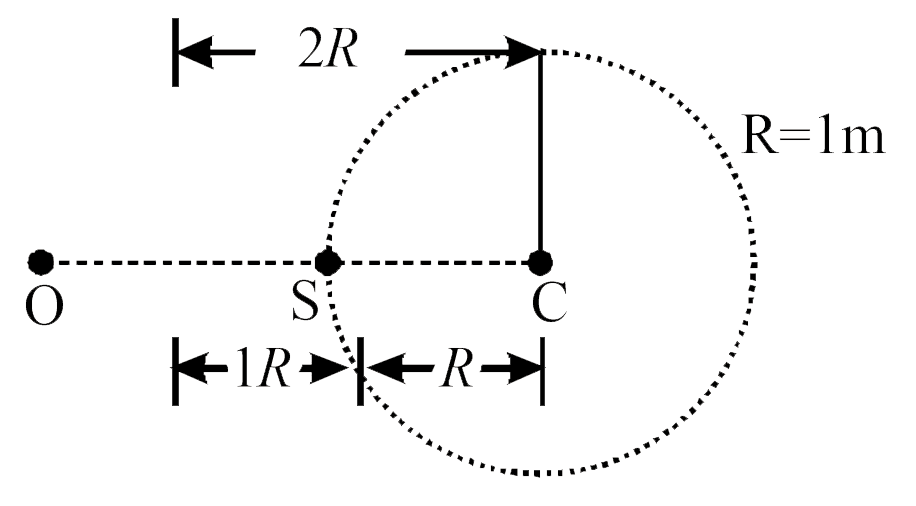
Sound emitted by the source at two successive instants `t_(1)` and `t_(2)` has minimum and maximum observed pitch respectively, then –
View SolutionStatement-1 : Particle velocity and wave velocity both are independent of time.
Statement-2 : For the propagation of wave motion, the medium must have the properties of elasticity and inertia.
View SolutionStatement-1 : Speed of wave `("Wavelength")/("Time period")`
Statement-2 : Wavelength is the distance between two nearest particles vibrating in phase.
View SolutionAssertion: Transverse waves are not produced in liquids and gases.
Reason: Light waves are transverse waves.
View Solution
physics questions and complete solutions for chapter WAVES of DISHA PHYSICS (HINGLISH) of Class 12